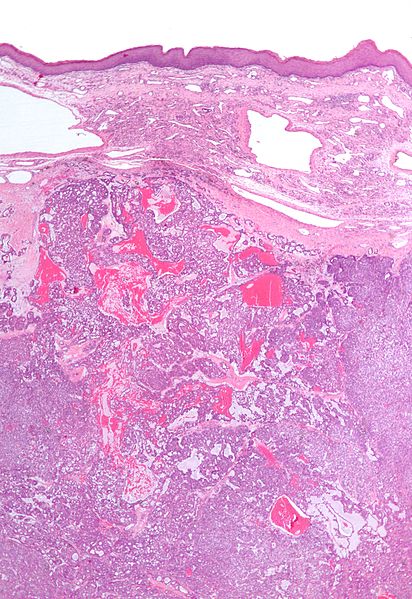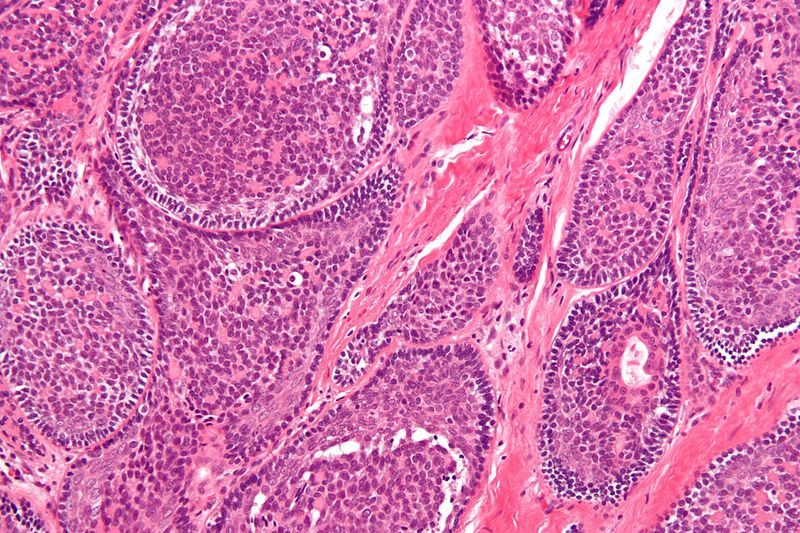Salivary gland tumor pathophysiology: Difference between revisions
Simrat Sarai (talk | contribs) |
Simrat Sarai (talk | contribs) No edit summary |
||
| Line 5: | Line 5: | ||
The pathophysiology of salivary gland tumors depends on the histological subtype.<ref name="librepathology"> Salivary glands. Libre pathology(2015) http://librepathology.org/wiki/index.php/Salivary_glands Accessed on November 11, 2015</ref> | The pathophysiology of salivary gland tumors depends on the histological subtype.<ref name="librepathology"> Salivary glands. Libre pathology(2015) http://librepathology.org/wiki/index.php/Salivary_glands Accessed on November 11, 2015</ref> | ||
==Pathophysiology== | ==Pathophysiology== | ||
The [[parotid gland]] is the most frequent site of salivary gland tumors which accounts for approximately 80 to 85 percent of these tumors.<ref>Barnes, Leon. Pathology and genetics of head and neck tumours. Lyon: IARC Press, 2005. Print.</ref><ref>{{Cite journal | |||
| author = [[Marco Guzzo]], [[Laura D. Locati]], [[Franz J. Prott]], [[Gemma Gatta]], [[Mark McGurk]] & [[Lisa Licitra]] | title = Major and minor salivary gland tumors | |||
| journal = [[Critical reviews in oncology/hematology]] | volume = 74 | issue = 2 | pages = 134–148 | year = 2010 | month = May | doi = 10.1016/j.critrevonc.2009.10.004 | |||
| pmid = 019939701}}</ref> About 75 percent of parotid lesions are benign and approximately 25 percent are malignant.<ref>{{Cite journal | author = [[R. H. Spiro]] | |||
| title = Salivary neoplasms: overview of a 35-year experience with 2,807 patients | journal = [[Head & neck surgery]] | volume = 8 | issue = 3 | pages = 177–184 | year = 1986 | month = January-February | pmid = 03744850}}</ref> | |||
Less frequently, salivary gland tumors originate in the [[sublingual]], [[submandibular]], and minor salivary glands, which are located throughout the submucosa of the upper aerodigestive tract and mouth.<ref>{{Cite journal | author = [[Marco Guzzo]], [[Laura D. Locati]], [[Franz J. Prott]], [[Gemma Gatta]], [[Mark McGurk]] & [[Lisa Licitra]] | |||
| title = Major and minor salivary gland tumors | journal = [[Critical reviews in oncology/hematology]] | volume = 74 | issue = 2 | pages = 134–148 | year = 2010 | |||
| month = May | doi = 10.1016/j.critrevonc.2009.10.004 | pmid = 019939701}}</ref> | |||
*In comparison to tumors arising in the parotid, 70 to 90 percent of sublingual gland tumors, 50 to 75 percent of minor salivary gland tumors, and 40 to 45 percent of [[submandibular]] gland tumors are [[malignant]]. Approximately 85% of salivary gland tumors occur in the parotid glands, followed by the minor salivary glands and submandibular, and about 1% occur in the [[sublingual]] [[glands]]. Overall approximately 80% of all parotid masses are benign.<ref name="radio"> Salivary gland tumors. Radiopedia(2015) http://radiopaedia.org/articles/salivary-gland-tumours Accessed on November 8, 2015</ref> | |||
*Histologically, [[pleomorphic adenoma]] is the most common type of benign salivary gland tumor, which comprises about half of all salivary tumors. Other rarer benign salivary gland tumors include [[basal cell]] [[adenoma]], [[Warthin]] [[tumor]], and [[canalicular adenoma]]. The most common malignant salivary gland tumors are [[adenoid]] [[cystic]] carcinoma and [[mucoepidermoid]] carcinoma, which together constitute approximately one-half of all malignant salivary gland tumors. | |||
===Histological features of benign tumors=== | ===Histological features of benign tumors=== | ||
{| style="border: 0px; font-size: 90%; margin: 3px; width: 800px;" align=center | {| style="border: 0px; font-size: 90%; margin: 3px; width: 800px;" align=center | ||
Revision as of 04:00, 14 November 2015
|
Salivary gland tumor Microchapters |
|
Diagnosis |
|---|
|
Treatment |
|
Case Studies |
|
Salivary gland tumor pathophysiology On the Web |
|
American Roentgen Ray Society Images of Salivary gland tumor pathophysiology |
|
Risk calculators and risk factors for Salivary gland tumor pathophysiology |
Editor-In-Chief: C. Michael Gibson, M.S., M.D. [1]Associate Editor(s)-in-Chief: Simrat Sarai, M.D. [2]
Overview
The pathophysiology of salivary gland tumors depends on the histological subtype.[1]
Pathophysiology
The parotid gland is the most frequent site of salivary gland tumors which accounts for approximately 80 to 85 percent of these tumors.[2][3] About 75 percent of parotid lesions are benign and approximately 25 percent are malignant.[4] Less frequently, salivary gland tumors originate in the sublingual, submandibular, and minor salivary glands, which are located throughout the submucosa of the upper aerodigestive tract and mouth.[5]
- In comparison to tumors arising in the parotid, 70 to 90 percent of sublingual gland tumors, 50 to 75 percent of minor salivary gland tumors, and 40 to 45 percent of submandibular gland tumors are malignant. Approximately 85% of salivary gland tumors occur in the parotid glands, followed by the minor salivary glands and submandibular, and about 1% occur in the sublingual glands. Overall approximately 80% of all parotid masses are benign.[6]
- Histologically, pleomorphic adenoma is the most common type of benign salivary gland tumor, which comprises about half of all salivary tumors. Other rarer benign salivary gland tumors include basal cell adenoma, Warthin tumor, and canalicular adenoma. The most common malignant salivary gland tumors are adenoid cystic carcinoma and mucoepidermoid carcinoma, which together constitute approximately one-half of all malignant salivary gland tumors.
Histological features of benign tumors
| Entity | Architecture | Morphology | Cell borders | Cytoplasm | Nucleus | Differential Diagnosis | Other |
|---|---|---|---|---|---|---|---|
| Pleomorphic adenoma | Variable | Mixed proportion; must include:
|
Variable | Variable | Plasmacytoid | Adenoid cystic carcinoma | Occasionally encapsulated, mixed proportion of glandular, myoepithelial and mesenchymal cells |
| Warthin tumor | Papillary, bilayer | Cuboid (basal), columnar (apical) | Clearly seen | Eosinophilic, abundant | Unremarkable | Sebaceous lymphadenoma | AKA papillary cystadenoma lymphomatosum |
| Basal cell adenoma | Variable, islands surrounded by hyaline bands, lesion encapsulated | Basaloid | Subtle | Scant, hyperchromatic | Granular | Basal cell adenocarcinoma | |
| Canalicular adenoma | Chains of cells | Cuboid or columnar | Subtle | Scant, hyperchromatic | Granular | Basal cell adenoma | Exclusively oral cavity, 80% in upper lip; immunohistochemistry: p63- |
| Sialoblastoma | Variable, islands surrounded by loose fibrous stroma | Basaloid | Subtle | Scant, hyperchromatic | Granular | Adenoid cystic carcinoma | Basal cell adenocarcinoma |
Histological features of malignant tumors
| Entity | Architecture | Morphology | Cell borders | Cytoplasm | Nucleus | Differential Diagnosis | Other |
|---|---|---|---|---|---|---|---|
| Mucoepidermoid carcinoma | Cystic and solid | Epitheloid | Distinct | Fuffy, clear, abundant | Nuclei small | SCC (?) | Immunohistochemistry: p63+ |
| Adenoid cystic carcinoma (AdCC) | Pseudocysts, cribriform, solid, hyaline stroma | Epitheloid | Subtle | Scant, hyperchromatic | Small+/-"carrot-shaped" | Pleomorphic adenoma, Polymorphous low grade adenocarcinoma (PLGA) | Stains: PAS+ (pseudocyst material), CD117+, cyclin D1+ |
| Acinic cell carcinoma (AcCC) | Sheets, acinar (islands) | Epithelioid | Clear | Granular abundant | Stippled, +/-occasional nucleoli | Adenocarcinoma not otherwise specified, oncocytoma of salivary gland | Stains: PAS +ve, PAS-D +ve; Immunohistochemistry: S-100 -ve, p63 -ve |
| Salivary duct carcinoma | Glandular, cribriform | Columnar | Subtle/clear | Hyperchromatic | Columnar | Metastatic breast carcinoma | Similar to ductal breast carcinoma; male>female |
| Polymorphous low-grade adenocarcinoma | Variable, often small nests, may be targetoid | Epithelioid | Indistinct | Eosinophilic | Ovoid & small with small nucleoli | Adenoid cystic carcinoma (AdCC) | Minor salivary gland tumour, often in palate, cytologically monotonous; IHC: S-100+, CK+, vim.+, GFAP+/-, BCL2+/- |
| Epithelial-myoepithelial carcinoma | Nests (myoepithelial) with tubules (epithelial) | Epithelioid | Not distinct | Eosinophilic cytoplasm; epithelial: scant; myoepithelial: moderate | Focal clearing | Adenoid cystic carcinoma (AdCC), pleomorphic adenoma | Rare |
| Basal cell adenocarcinoma | Variable, islands surrounded by hyaline bands, lesion not encapsulated | Basaloid | Subtle | Scant, hyperchromatic | Granular | Basal cell adenoma | Rare, usually parotid gland, may arise from a basal cell adenoma |
-
Polymorphous low-grade adenocarcinoma
-
Warthin tumor
-
Adenoid cystic carcinoma
-
Basal cell adenocarcinoma
-
Epithelial-myoepithelial carcinoma
-
Salivary duct carcinoma
-
Mucoepidermoid carcinoma
-
Pleomorphic adenoma
-
Acinic cell carcinoma
References
- ↑ Salivary glands. Libre pathology(2015) http://librepathology.org/wiki/index.php/Salivary_glands Accessed on November 11, 2015
- ↑ Barnes, Leon. Pathology and genetics of head and neck tumours. Lyon: IARC Press, 2005. Print.
- ↑ Marco Guzzo, Laura D. Locati, Franz J. Prott, Gemma Gatta, Mark McGurk & Lisa Licitra (2010). "Major and minor salivary gland tumors". Critical reviews in oncology/hematology. 74 (2): 134–148. doi:10.1016/j.critrevonc.2009.10.004. PMID 019939701. Unknown parameter
|month=ignored (help) - ↑ R. H. Spiro (1986). "Salivary neoplasms: overview of a 35-year experience with 2,807 patients". Head & neck surgery. 8 (3): 177–184. PMID 03744850. Unknown parameter
|month=ignored (help) - ↑ Marco Guzzo, Laura D. Locati, Franz J. Prott, Gemma Gatta, Mark McGurk & Lisa Licitra (2010). "Major and minor salivary gland tumors". Critical reviews in oncology/hematology. 74 (2): 134–148. doi:10.1016/j.critrevonc.2009.10.004. PMID 019939701. Unknown parameter
|month=ignored (help) - ↑ Salivary gland tumors. Radiopedia(2015) http://radiopaedia.org/articles/salivary-gland-tumours Accessed on November 8, 2015








